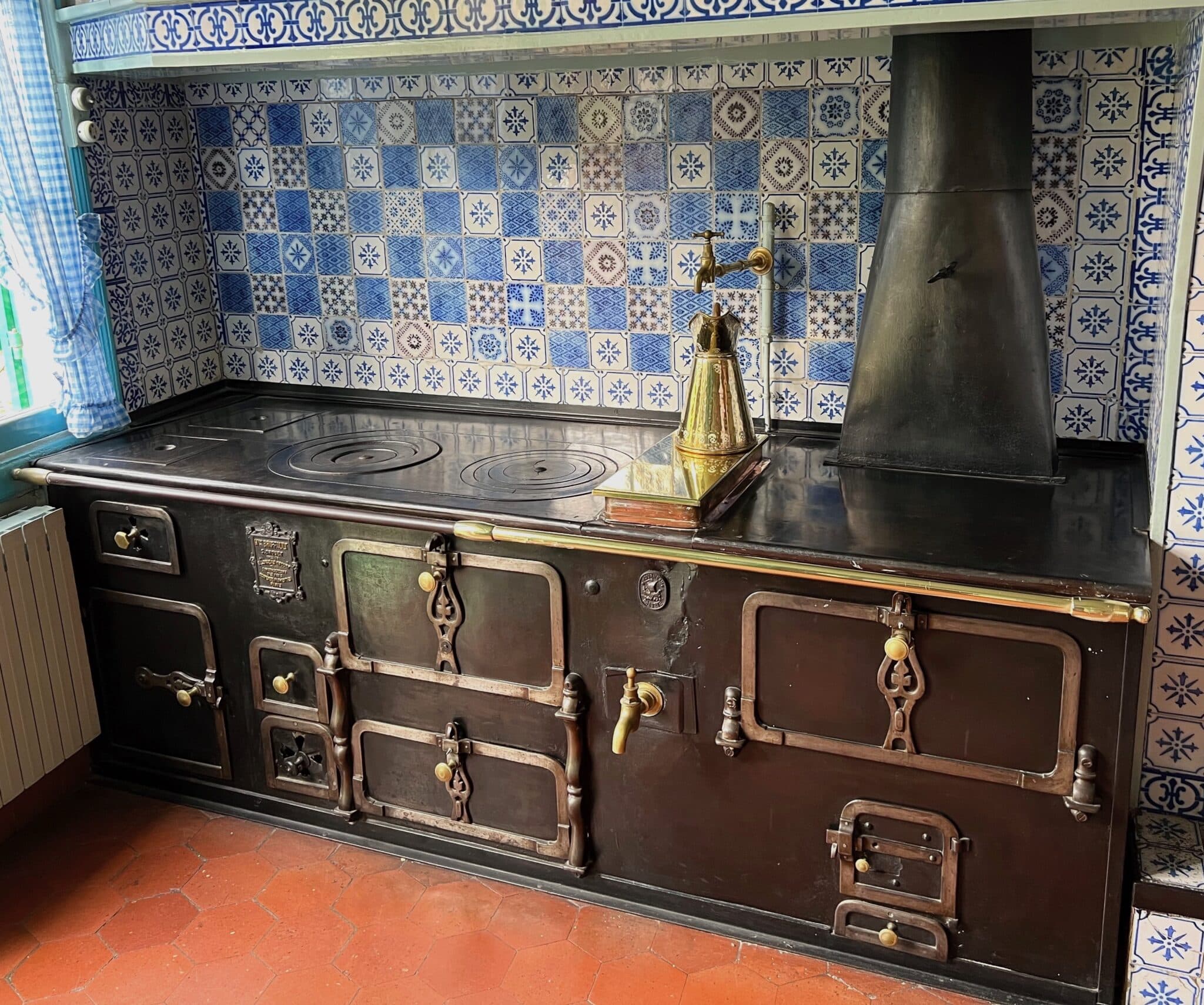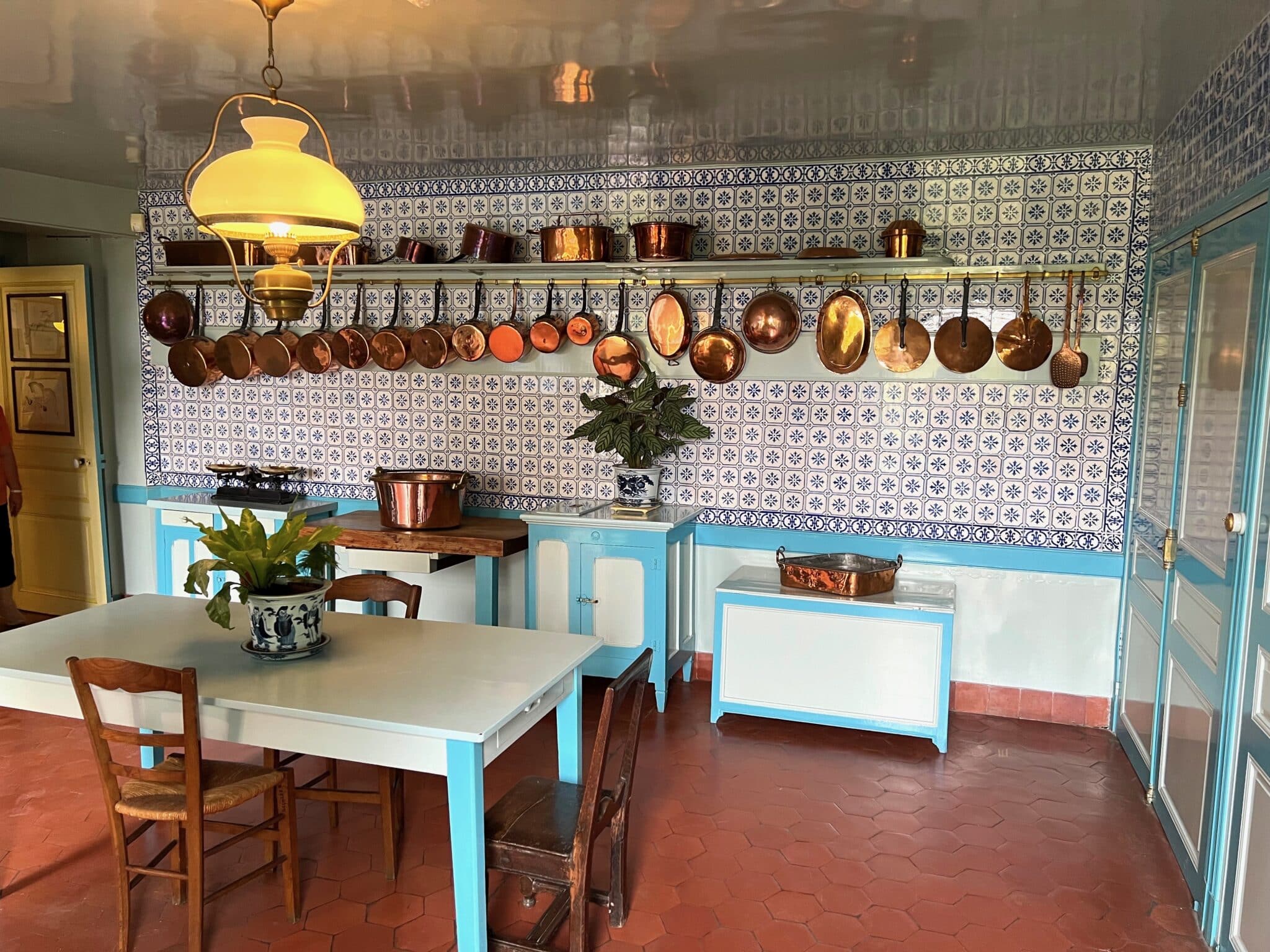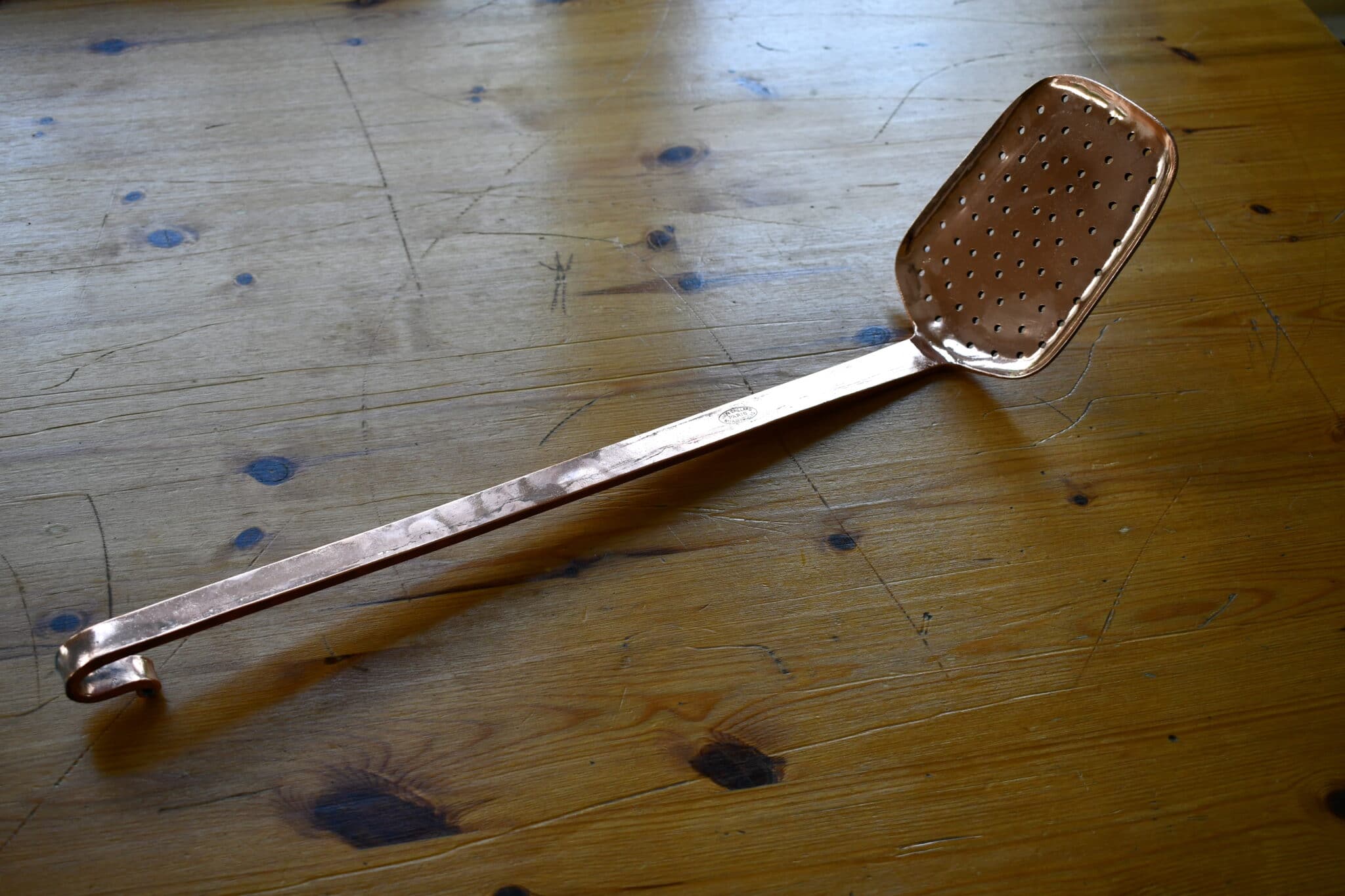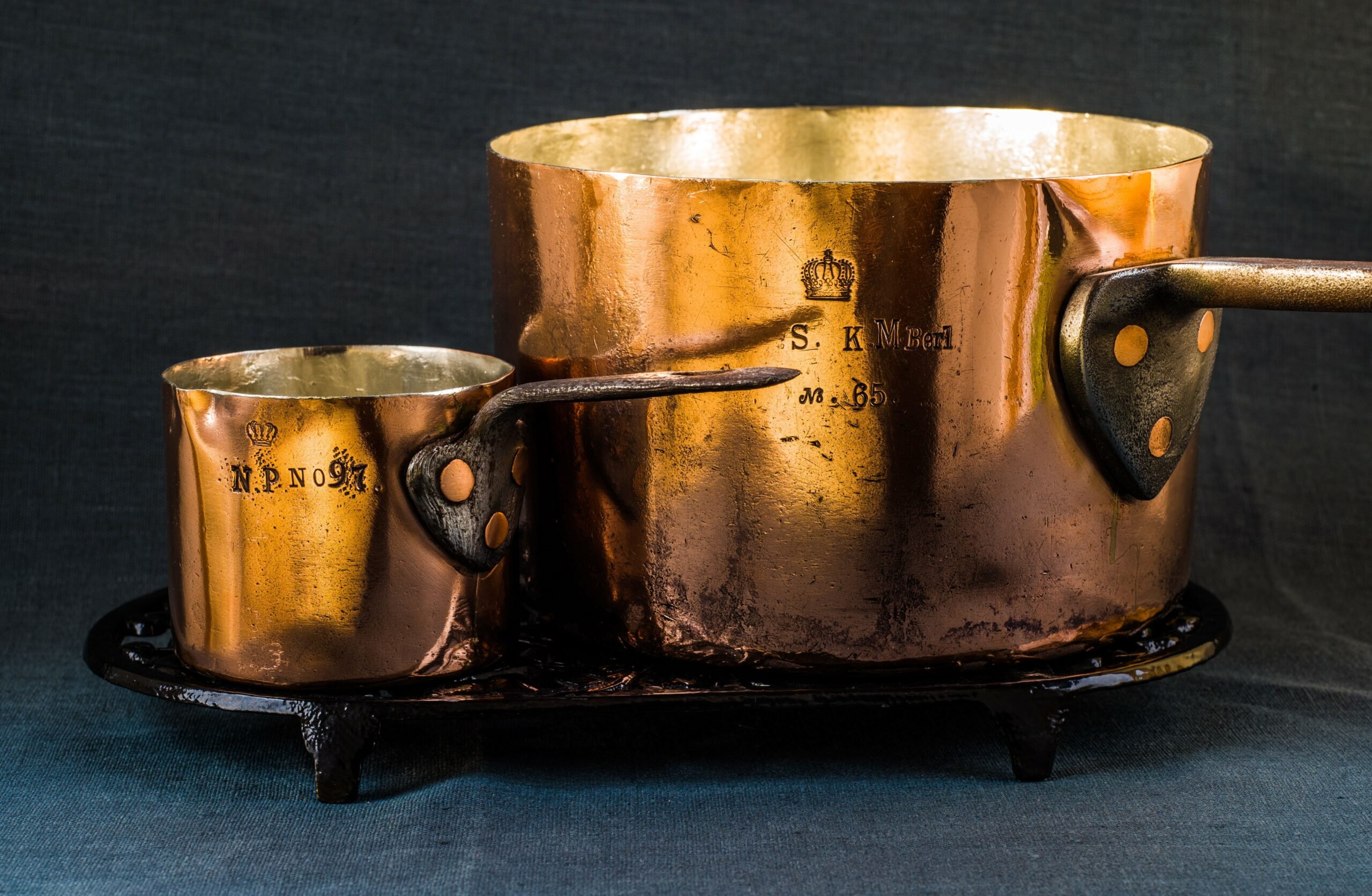Before the industrial revolution, poêliers in Villedieu forged and shaped copper pots completely by hand.
In 1898, Auguste Lavalley captured narratives from two Villedieu poêliers of the 19th century to describe this process in detail. I found it fascinating and worth translating for my English language readers, and links to the original French documents are at the end of the post. I’ve made a few minor edits for clarity and flow; remarks in parenthesis are in the original text, while anything in brackets is my own addition.
Making pots and pans
Poêlerie was the industry in Villedieu of making poêles [pans] or large pots, cauldrons, milk canisters, and so on with copper and brass melted, beaten and shaped with a hammer. Before the rolling mill that today provides for the manufacture of blanks or sheets of copper of all sizes, the industry of Villedieu made its own by melting old metals or scrap in a room belonging to the brotherhood of poêliers called the Foyer. The old Foyer was situated in the Rue Haute, in the courtyard which has kept the name of Cour Foyer or Cour d’Huard; and the last one was a little higher, in a courtyard on Chenots Street.
Before forging the old metal or mitraille [bits of scavenged metal], they were annealed in the vast chimneys of the shops or batteries, and to do this, we placed in the airat — the hearth of these chimneys — several logs of forked wood that furnished the bed on which the old mitraille were piled up. At daybreak, these pieces were set on fire and the flame enveloped the mitrailles to be annealed and heated them white hot, which made it possible to break (briser) them into small pieces that could be placed in the crucibles.
 Hence the name of brisou given to this operation, and that of briseresses or ainderesses carried by the women who helped in this work, which was carried out by means of small shovels or palettes with which one struck the red-hot mitraille against the ground to break it. (After the brisou, we would wash away the garbage and collect a baked earth shell called écaille de boë or mud shell, which we sold to glaze earthenware pottery. The chips that escaped from the anvils were also melted into ingots by a special worker, M. Gautier-Jardinière, who sold these ingots to the makers of cabinet fittings.)
Hence the name of brisou given to this operation, and that of briseresses or ainderesses carried by the women who helped in this work, which was carried out by means of small shovels or palettes with which one struck the red-hot mitraille against the ground to break it. (After the brisou, we would wash away the garbage and collect a baked earth shell called écaille de boë or mud shell, which we sold to glaze earthenware pottery. The chips that escaped from the anvils were also melted into ingots by a special worker, M. Gautier-Jardinière, who sold these ingots to the makers of cabinet fittings.)
It was a most painful work because, in addition to the heat, there was also smoke that blinded and blackened the workers, so that they dripped with sweat and ended up looking like the mythical Cyclops. (Hence this expression particular to Villedieu to say that when a chimney smokes heavily, “it smokes like a brisou.”)
After the mitrailles were broken, they were shaken in large colanders pierced with holes called crêles, grêles, or crâles, in order to get rid of slag, charcoal, and fragments, and then they were rinsed to remove dust.
 This mitraille, broken and cleaned, was then brought to the foyer where it was cast in leaden crucibles in the bottom of a covered furnace. Each crucible contained about 25 kilograms of melted scrap intended to make a table [sheet of raw metal]. Before the molding, that is to say, the pouring of the metal between the stones we will describe in a moment, we added to the melted mitraille some limaille d’épingles [pinpricks] to make the material more ductile.
This mitraille, broken and cleaned, was then brought to the foyer where it was cast in leaden crucibles in the bottom of a covered furnace. Each crucible contained about 25 kilograms of melted scrap intended to make a table [sheet of raw metal]. Before the molding, that is to say, the pouring of the metal between the stones we will describe in a moment, we added to the melted mitraille some limaille d’épingles [pinpricks] to make the material more ductile.
 The molding operation was between two large flat granite stones about 1m 30cm long and 1m wide, about 25cm thick, resting on each other. The one from above was raised as needed by means of a pulley. They were separated from each other by three flat iron plates of 5mm to 6mm thick that were called chambres and which were placed on the lower stone, one on the left, the other on right, and the third at the opposite end from where the metal was poured, so as to determine exactly the thickness of the sheet that was to be molded between these plates. The two stones, before being superimposed on one another (the one above resting on the chambres), were coated with cow dung to prevent the adhesion of the metal with the stones.
The molding operation was between two large flat granite stones about 1m 30cm long and 1m wide, about 25cm thick, resting on each other. The one from above was raised as needed by means of a pulley. They were separated from each other by three flat iron plates of 5mm to 6mm thick that were called chambres and which were placed on the lower stone, one on the left, the other on right, and the third at the opposite end from where the metal was poured, so as to determine exactly the thickness of the sheet that was to be molded between these plates. The two stones, before being superimposed on one another (the one above resting on the chambres), were coated with cow dung to prevent the adhesion of the metal with the stones.
 Before the molding, the two stones were squeezed in the presses to prevent them from deviating and tipped at an incline from the open end. At the point of pouring metal between the stones, a woman came with a cloth to clean the top of the crucible to remove any scum that could create foam, and then left the cloth to burn away to prevent foreign matter from mixing with the metal. This operation was called sincer. (Perhaps from the base Latin verb sincero, to make pure, purify.)
Before the molding, the two stones were squeezed in the presses to prevent them from deviating and tipped at an incline from the open end. At the point of pouring metal between the stones, a woman came with a cloth to clean the top of the crucible to remove any scum that could create foam, and then left the cloth to burn away to prevent foreign matter from mixing with the metal. This operation was called sincer. (Perhaps from the base Latin verb sincero, to make pure, purify.)
The master poêliers took turns at the Foyer according to an amicable order established between them. (But never twice in a row, perhaps in accordance with ancient French law that dictated that each forging job had to be complete before another could commence.) Each production run at the forge was called a cure and produced 600 kilograms of metal, but could sometimes go up to 730 kilograms when they wanted to forge sheets to make long thin strips. Each cure consisted of 12 presses producing two sheets at a time, in all twenty-four sheets usually weighing 25 kilograms each (sometimes 30 or 31 kilograms).
 The poêliers worked two by two. Each pair was called a tronc. One of the workmen was called the battoux, the other the troussioux. The battoux was the one who held the piece on the anvil and donnait à battre [steadied it for striking] for the troussioux, who beat on it. The battoux had on his knees two pads of coarse cloth or rags covered with old pieces of leather, which were called savattes, which served to dampen the counter-stroke of the anvil on which the troussioux struck.
The poêliers worked two by two. Each pair was called a tronc. One of the workmen was called the battoux, the other the troussioux. The battoux was the one who held the piece on the anvil and donnait à battre [steadied it for striking] for the troussioux, who beat on it. The battoux had on his knees two pads of coarse cloth or rags covered with old pieces of leather, which were called savattes, which served to dampen the counter-stroke of the anvil on which the troussioux struck.
 After the forging, the first operation of the poêliers was to tailler, to cut from the forged sheets by means of a cold chisel called a sasset the square pieces proportionate to the size of the objects to be made. (For example, to make one of the panels of a 5-pot [10 liter] milk canister, a piece of about 9 square centimeters was cut.)
After the forging, the first operation of the poêliers was to tailler, to cut from the forged sheets by means of a cold chisel called a sasset the square pieces proportionate to the size of the objects to be made. (For example, to make one of the panels of a 5-pot [10 liter] milk canister, a piece of about 9 square centimeters was cut.)
Before being delivered to the chaudronniers who were to finish them, the pieces to which the poêliers had given shape and raw form were passed twenty-five or thirty times in the forge and annealed with hammering after each operation, each of which consisted of several heatings. Each annealing was called a chaude.
 These pieces were left to anneal on the airat between bricks of mud clay that were called chemins, with which one built a kind of small round tower to contain the pieces piled on one another, with wood charcoal packed under, over, and around each piece.
These pieces were left to anneal on the airat between bricks of mud clay that were called chemins, with which one built a kind of small round tower to contain the pieces piled on one another, with wood charcoal packed under, over, and around each piece.
Each stacked row of chemins was called a route, and the tower or chimney so constructed bore the name of foye. These foyes were watched very carefully so that there would be no breaks or lines of fire, and one by one as the high basins were annealed, we pulled one row and rearranged the chemins until they were all done; sometimes we spent most of the night watching.
After the tailler, the next step was to ébarbillonner, to remove any barbs or burrs on the edge of the sheets at the time of forging, and then tacoter [tapping], to flatten the cut pieces by hitting them here and there with hammers to even them out.
 After the tacoter came the first stretching operation which was called bassiner, starting from the center and ending at the edges of each side of the square. For this operation, we used the hammer called brille en air (in the vulgate, brianlait). (It is this hammer, whose polished steel head shone in the air, that our venerable compatriots had, wrongly, the reputation of wanting to throw at the head of the foreigners who asked them the time.)
After the tacoter came the first stretching operation which was called bassiner, starting from the center and ending at the edges of each side of the square. For this operation, we used the hammer called brille en air (in the vulgate, brianlait). (It is this hammer, whose polished steel head shone in the air, that our venerable compatriots had, wrongly, the reputation of wanting to throw at the head of the foreigners who asked them the time.)
After several heatings, the pieces were:
- At changer de marteau [changing of the hammer], ready to leave the flat anvil and be beaten on the hollow anvil;
- Needing mouiller dessous [to be moistened below] with the salivet, a piece of hempen cloth soaked in water to wet the underside of basins before beating them;
- Needing mouiller dessus ou dedan [to be moistened on top or inside], same operation as the previous one, on the other side of the piece.
It happened that from the course of these works the pieces were no longer sound, or had become gauchissaient [warped or buckled] according to the expression; they were beaten sur le genou [on the knee] to straighten them. This operation was called déflanchir.
 Each time the pieces were annealed and beaten, they were passed over to the comornoux, who took up each piece and struck it with the hammer to comorner and straighten it out. This operation was similar to déflanchir, but instead of striking his knee, the comornoux struck a kind of rounded steel anvil placed in a block of wood sunk into the ground.
Each time the pieces were annealed and beaten, they were passed over to the comornoux, who took up each piece and struck it with the hammer to comorner and straighten it out. This operation was similar to déflanchir, but instead of striking his knee, the comornoux struck a kind of rounded steel anvil placed in a block of wood sunk into the ground.
The piece was then poinçonné [marked]. This operation consisted of finding the center of the piece (where one made a mark with the poinçon) by means of a sort of round ruler called a cerne. There was the cerne du fond [for the base] and the cerne de haut [for the top] to mark the depth and the diameter. There was also the bauche and the riole or right-angle ruler. All these instruments were primitive and the different graduations were marked by cuts or notches.
To see if the piece was of equal thickness on all sides, it was turned upside down and placed on the point of the poinçon to see if it would balance. If it leaned to one side or another, it had not been evenly thinned and had to be hammered again to take the thickness from one side to the other. It was called lignonner to reheat the same side of the piece twice in order to help draw the thickness away. They then beat the thinned pieces two by two, then three by three together.
 Up until this point, the pieces were all square. The next step was sartiller or sertiller to make them round. This operation consisted in cutting angles into the piece and joining them to put it in cuvelettes [cups]. Another operation that was called moucher [trimming] was to strike at the edges to thin them.
Up until this point, the pieces were all square. The next step was sartiller or sertiller to make them round. This operation consisted in cutting angles into the piece and joining them to put it in cuvelettes [cups]. Another operation that was called moucher [trimming] was to strike at the edges to thin them.
The pieces were then stacked three by three, sometimes four by four, one into the other, and they were packaged up, and for cauldrons and canisters in a third or fourth that was a little larger and whose edges were folded over to form a package that was called a cuvelette. For large pans, the cuvelettes were attached together by means of pieces of copper curved to form clips that were called contillons.
 For these different works, besides the brille en air and the comorner hammer mentioned above, the poêliers still had several other hammers: the hammer à bliner, the large, the demi-large, the larchaud, the hammer à chaver, the hammer à faire le bord, the one to beat in parfonds.
For these different works, besides the brille en air and the comorner hammer mentioned above, the poêliers still had several other hammers: the hammer à bliner, the large, the demi-large, the larchaud, the hammer à chaver, the hammer à faire le bord, the one to beat in parfonds.
After each heating the pieces were measured with the bauche [ruler]. In order for the work to be done well, it was necessary that in each heating the piece grew a notch.
 Finally, when the cuvelettes had arrived at their normal size, they were to be surir or desevrer [separated]: the edges of the join were cut and the pieces were removed from each other. When the pieces were separated out, it was necessary to look for traces of scorching or cracks, which obliged them to be soldered and cut into pieces.
Finally, when the cuvelettes had arrived at their normal size, they were to be surir or desevrer [separated]: the edges of the join were cut and the pieces were removed from each other. When the pieces were separated out, it was necessary to look for traces of scorching or cracks, which obliged them to be soldered and cut into pieces.
 To smooth and free welds or welded parts, they were filed with a kind of bent file called a gohenne. There was another kind of gohenne used to file or grate the anvils.
To smooth and free welds or welded parts, they were filed with a kind of bent file called a gohenne. There was another kind of gohenne used to file or grate the anvils.
The chaudronniers [boilermakers] were then responsible for completing the work.
 It was called blanchir [polishing] to scrape pans and cauldrons with an iron which is called fer à parer to unite them and make them bright and shiny; lanter, to planish the pot with separate hammer strikes in rows, in such a manner that the hammer marks are like a string of beads. These two operations were not the responsibility of the poêliers, but the blanchissoux and lantoux.
It was called blanchir [polishing] to scrape pans and cauldrons with an iron which is called fer à parer to unite them and make them bright and shiny; lanter, to planish the pot with separate hammer strikes in rows, in such a manner that the hammer marks are like a string of beads. These two operations were not the responsibility of the poêliers, but the blanchissoux and lantoux.
 When they were working at night, which was seldom the case, the poêliers borrowed from the chaudronniers the begat, a kind of wooden support pierced with superimposed holes, into which the stem of the tué was thrust down, a kind of candlestick into which they put the candle; to anneal the foyes, they used resin or petoche to light themselves.
When they were working at night, which was seldom the case, the poêliers borrowed from the chaudronniers the begat, a kind of wooden support pierced with superimposed holes, into which the stem of the tué was thrust down, a kind of candlestick into which they put the candle; to anneal the foyes, they used resin or petoche to light themselves.
A cure of twelve presses took at least three months (twelve weeks of work). Every week, the poêliers took a certain sum from the boss against what would be due to them à fin de forge [at the end of the forging] when the work was finished; so we counted. If there had been any unemployment, illness, or impediments, and if the labor had lasted longer than usual, the poêliers owed the owners; if, on the contrary, they had worked quickly, they received a sum for their account, called the fin de forge. In addition to the weekly salary, they each had the right each day to a pot (2 liters) of cider provided by the boss.
This industry which, fifty years ago, counted in Villedieu more than one hundred twenty or one hundred thirty poêliers, diminished little by little and eventually died out in 1876. Today (1898) there are only two or three workers left who worked in the trade, and only one poêlier proper, Jules Engerran, who is seventy years old.
(This work was written on the notes that my father, Alphonse Lavalley, former poêlier-chaudronnier, made me take in 1872; it was completed by the information provided by said Mr. Jules Engerran. There may still be some omission, but he gives an exact idea of the manufacture of the poêles, and I insisted on preserving especially the expressions employed by our good poêlier.)
March 1898
Auguste Lavalley
Source
Villedieu-lès-Poëles, sa commanderie, sa bourgeoisie, ses métiers; Grente, Joseph (1863-1941), and Havard, Oscar (1845-1922). Champion (Paris), 1899-1900. Preserved by the Bibliothèque nationale de France, département Philosophie, histoire, sciences de l’homme, and available in the public domain.
- Villedieu-les-Poeles_sa_commanderie_sa_bourgeoisie_Part_1 covers the year 1100 to the end of the ancien regime. (Also available on Gallica.)
- Villedieu-les-Poeles_sa_commanderie_sa_bourgeoisie_Part_2 covers the French Revolution to the 19th century. (Also available on Gallica.)
This post is translated from Part 2, Appendix I, Fabrication de la poëlerie, starting on page 629. I used a combination of machine translation and my own editing.





